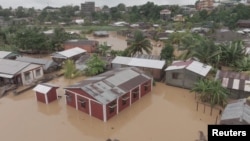High winds ripped down trees and torrents of water gushed through villages after the cyclone, which was initially projected to skim the Indian Ocean island, changed course and made landfall in the north on Wednesday.
According to statistics released on Friday by the national risk and disaster management office (BNRGC), 20,737 people have been displaced and 5,371 households affected.
Some victims had drowned, while others were killed by collapsing houses or falling trees, authorities said.
A previous death toll had stood at 11.
Due to the floods "we have nothing to eat. What's more, our children are sick because of the dirty water," Pasy, a middle-aged woman in northeastern Sava region, told AFP.
"We are asking for help," she said, dripping from the rain, as locals helped each other out of deep gushing water which for some reached just below their necks.
They carried the last of their belongings that could be saved.
Numerous routes and bridges were flooded and cut off.
"We haven't eaten yet. All our coal stocks are flooded and the sacks of rice are washed away. We don't know what to do," shopkeeper Fregin said.
The cyclone moved slowly, amplifying its destructive impact.
"It's rare to have a cyclone like this. Its movement is nearly stationary," Elack Andriakaja, director general of the BNRGC, told AFP on Thursday.
"When the system stops in one place, it devastates all the infrastructure. And that has serious consequences for the population. And significant flooding," he added.
Gamane has been reclassified as a tropical storm and was expected to leave the island on Friday afternoon, according to meteorologists.
Cyclone season in the southwest of the Indian Ocean normally lasts from November to April and sees around a dozen storms each year.
18 Dead As Cyclone Gamane Hits Madagascar

ANTANANARIVO—A slow-moving cyclone that unexpectedly turned towards Madagascar has killed 18 people, washing away homes and displacing thousands, officials said Friday.






Forum